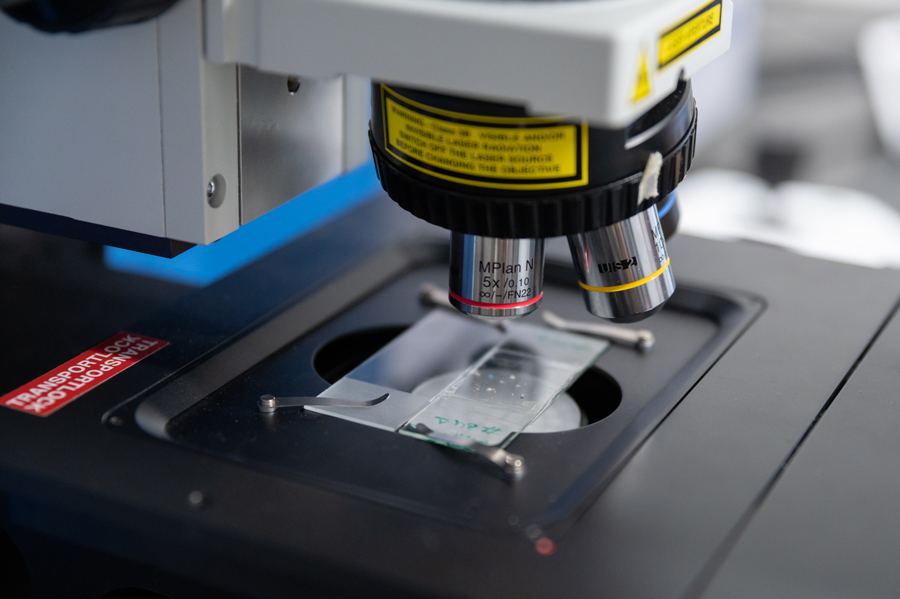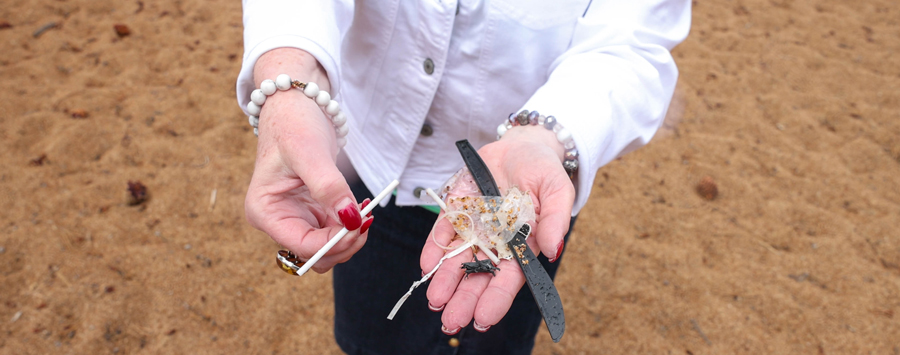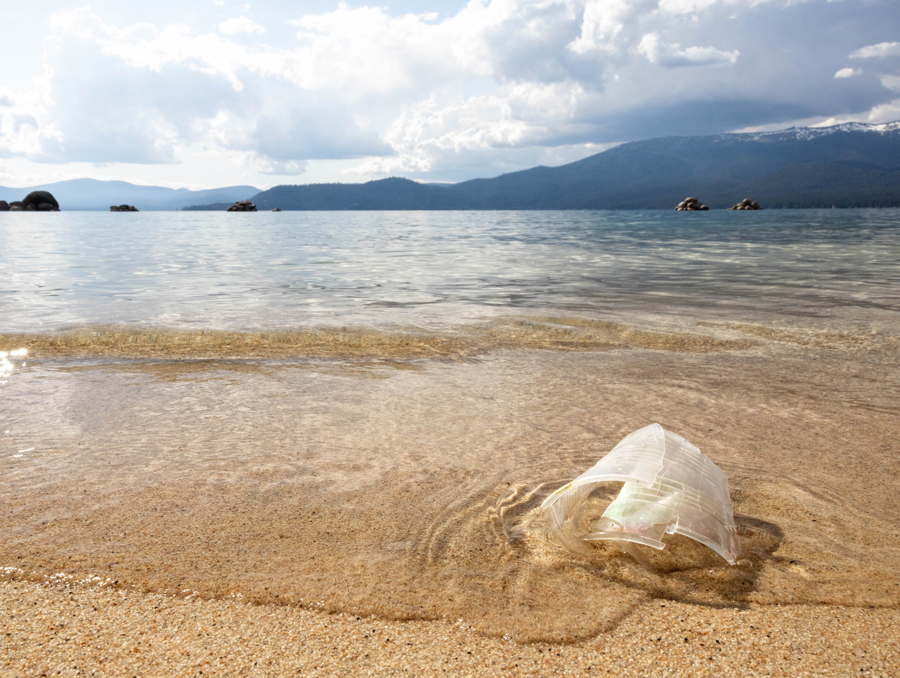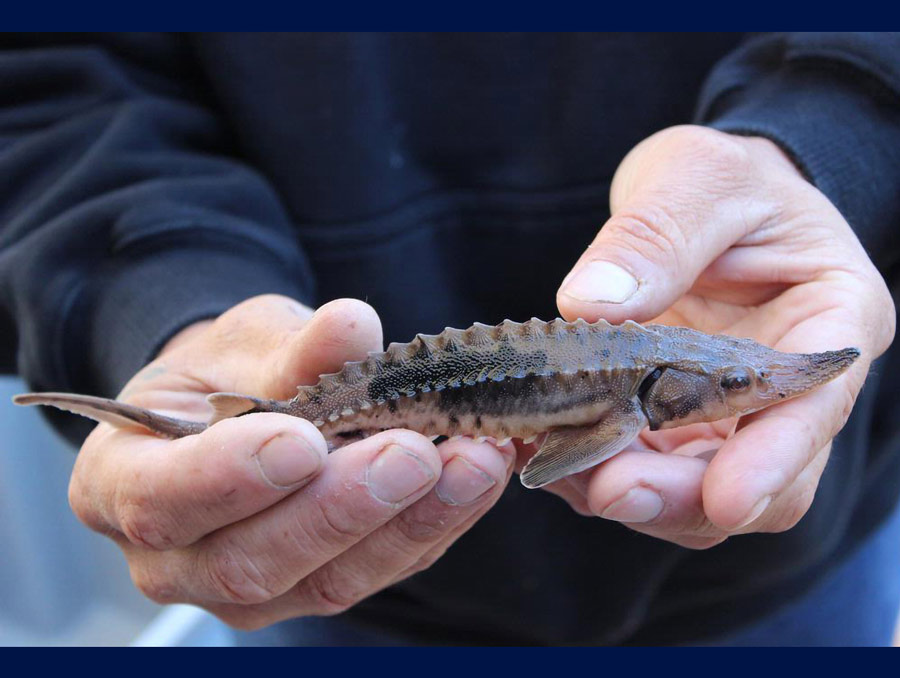Microplastics, small fragments of fibers from clothing, packaging, and other plastic residue have invaded freshwater lakes and watersheds globally and in alarming quantities, according to new research published in the scientific journal Nature under the title ‘Plastic debris in lakes and reservoirs.’ Lake Tahoe, known for its purity and high level of legal protection had the third highest concentration of plastic of 38 lakes tested around the world and higher than in the surface water at the ocean’s gyres where the floating islands of debris emblematic of the world’s plastic pollution crisis collect.
“One of the highest priorities at Lake Tahoe is to keep the water quality clear and pristine,” Sudeep Chandra, Professor of Limnology and Director of the Global Water Center at the University of Nevada, Reno, said. “Clarity is the signature of Lake Tahoe and the mantra Keep Tahoe Blue is not taken lightly. With this study, we now know that plastics exist in high concentrations in Lake Tahoe and could be having an impact on the ecosystem and the animals living in the lake. This shows us that there are always emerging issues that need to be addressed so we can try to preserve the lake into the future.”
Still unknown is how the plastics are entering these freshwater ecosystems, particularly in the Tahoe Basin. Even lakes mostly undisturbed by humans saw some level of microplastics.
“The results are remarkable because they show the extent of plastic concentrations in freshwater systems even in remote and highly protected areas,” Chandra, who is also University of Nevada, Reno at Lake Tahoe affiliated research faculty, said.
The global research was led by visiting postdoctoral scholar at the University of Nevada, Reno from the University of Milano-Bicocca in Italy, Veronica Nava. Under the supervision of Milano-Bicocca Professor Barbara Leoni, Nava worked with colleagues from around the world, including Chandra.
"We are wearing a lot of synthetic clothes, the majority of which are made of polyester, and they end up in aquatic systems. Even from far away, there can be atmospheric circulation and patterns that can carry these plastics a long way."

Postdoctoral researcher Veronica Nava in the Raman microspectroscopy laboratory in the Department of Earth and Environmental Sciences at the University of Milan-Bicocca analyzes water samples. (Image courtesy of the University of Milan-Bicocca)
“The mechanism of transport of these plastics is not clear, especially when we talk about very small fragments or textile fibers,” Nava said. “We are wearing a lot of synthetic clothes, the majority of which are made of polyester, and they end up in aquatic systems. Even from far away, there can be atmospheric circulation and patterns that can carry these plastics a long way.”
Another culprit is single-use plastics. These once-used and discarded items break down and are believed to enter the watershed in a number of ways.
“It’s not that plastics are not useful,” Nava said. “There are many applications where using plastics is necessary and other materials may be much more damaging to an ecosystem. There are some types of plastics, however, especially the single-use plastics, that can be avoided, eliminating it as a problem.”
Lake Tahoe has a record of science-driven conservation policies and programs to address human impacts. Not only has wastewater been transported out of the basin for decades, $660 million in water quality improvements have been invested through the Lake Tahoe Environmental Improvement Program. In June of this year, the region also began managing the impacts of outdoor recreation and tourism more holistically. The new Lake Tahoe Destination Stewardship Plan is tackling environmental issues facing the Lake Tahoe Basin, prioritizing litter enforcement and environmental sustainability and stewardship.
Julie Regan, executive director of the bi-state Tahoe Regional Planning Agency, added additional perspective about the findings.
“We’re absolutely concerned about the implications for human health as well as the lake’s vulnerabilities to microplastics. Lake Tahoe has been solving tough problems through science-driven policy for years,” Regan said. “If any area can work to understand microplastics and reduce the impacts, it’s our region. This area of research is relatively young and emerging questions are coming from each new study. Expanding our understanding of microplastics in the environment, how they travel, their sources, and their impacts, is a critical next step to make sure Tahoe doesn’t fall victim to a global problem.”
From global to local: how Lake Tahoe compares
Lead researcher Nava worked with colleagues from around the world, including Chandra, to collect samples from 38 lakes located in 23 different countries, spread across 6 continents and representing a range of environmental conditions. The team compared these to similarly sampled water in the subtropical ocean gyres currently considered some of the greatest plastic accumulation zones in the world.

The researchers used the Raman micro-spectroscopy to could confirm, with extreme accuracy, the polymeric composition of microplastics in the water samples, highlighting the presence especially of polyester, polypropylene and polyethylene. (Image courtesy of the University of Milan-Bicocca)
Filtering for plastic larger than 250 microns (about the width of three strands of hair), the researchers confirmed the presence of microplastics in all 38 lakes, highlighting high levels of plastic debris from textiles and clothing such as polyester, polypropylene, and polyethylene. Three of the lakes – Lakes Lugano and Maggiore at the Swiss-Italian border and Lake Tahoe – showed concentrations of microplastics higher than observed in the ocean gyres.
“If you consider the variables in our study that seemed to be connected to the presence of plastics, Lake Tahoe was different – we didn’t have any of these consistent variables,” Nava said.
Two types of lakes were shown to be particularly vulnerable – lakes in densely populated areas and large lakes with more ways for plastics to be deposited such as having a large watershed, greater water inflows, large shoreline length and greater shoreline development. Lakes Lugano and Maggiore, both densely populated and with wastewater inlets, saw the greatest concentrations of microplastics. Lake Tahoe, which had the third highest plastic levels, is an anomaly in the study. The area surrounding Lake Tahoe is not densely populated, wastewater has been exported for the past 50 years, and policies are in place to limit excess runoff into the lake.
“We still believe that the concentration of plastics is linked to the human presence, whether from leaving trash on the beach or other small ways where plastic can end up in the water,” Nava continued.
Large lakes like Lake Tahoe hold water for longer than smaller, shallower systems which can impact the accumulation of plastic debris. For Lake Tahoe, that timeline is 650 years. Additionally, the region sees large seasonal influxes of recreators using the lake.
“What this study underscores is that everyone has a role to play,” Regan said. “It’s our collective responsibility to take care of Lake Tahoe – to pick up our trash, leave no trace, leave only footprints on the Tahoe shoreline, and to be aware that our modern-day convenient lifestyle does come at a cost.”
The City of South Lake Tahoe recently banned the use of plastic bags as well as single-use plastic water bottles, which will go into effect in 2024. The non-profit League to Save Lake Tahoe has piloted the use of robots programmed to clean up trash on the lake shore and coordinates large community beach clean-ups. The Lake Tahoe Destination Stewardship Plan outlines additional priorities to combat plastic from entering the lake.
Understanding the impact

Julie Regan, executive director of the bi-state Tahoe Regional Planning Agency, holds trash found on Nevada Beach in South Lake Tahoe on Monday, June 12, 2023. (Jennifer Kent)
Chandra hopes to help Tahoe managers address the plastic issue by establishing where the plastic is coming from and how to keep it from accumulating in the lake, but also to understand the impacts of these high levels of microplastics in the lake. These include the potential transfer of plastic debris through the watershed into other systems, changes in the water’s nutrients or oxygen levels, and the infiltration of drinking water.
Although not explored in the current study, Chandra plans to pursue these answers in future research.
“At the University of Nevada, Reno at Lake Tahoe, we are poised to address this challenge,” Chandra said. “My hope is to conduct an experiment with Dr. Nava, as well as our colleagues from the Desert Research Institute, that evaluates the impact of plastics on Lake Tahoe. We are starting to design experiments now and hope to make a comparison with other lakes, and Northern California and Oregon as well as Italy.”
As research progresses, partnerships between scientists and organizations like TRPA, the League to Save Lake Tahoe, the Tahoe Fund, and other groups influential in planning and implementing conservation efforts will continue to prove essential.
“Protecting Lake Tahoe’s incredible water quality is at the center of everything we do and our conservation programs to control local pollutant sources have become a model for other areas,” Regan said. “Microplastics and other emerging issues have been on our radar for several years and we’re fortunate to have some of the world’s greatest scientists studying our lake and helping protect it. We hope these findings continue the long tradition of relying on science to guide policy and restoration programs to protect Lake Tahoe for generations to come.”
















